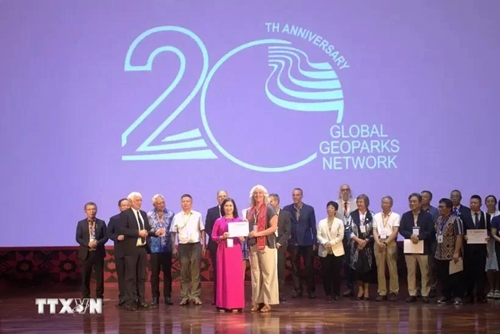With the theme of “Local/indigenous people and sustainable development in Geoparks,” the four-day event issued the Cao Bang joint statement that highlights the role of local or indigenous communities in the preservation and management work.
Relevant stakeholders, as well as local and regional authorities should be representatives in the management of UNESCO Global Geoparks, according to the document.
In order to enhance the empowerment of local communities and attract more visitors, the network identifies, protects, and optimizes the use of intangible heritage to tell stories about geological processes, history, culture, as well as the rituals and beliefs of locals, it said.
    |
 |
|
Individuals who have contributed greatly to the development of the UNESCO Global Geopark Network are honored on this occasion. |
Participants also emphasized the need to protect and promote all local or indigenous languages, as well as the existing knowledge systems within the territory of the geoparks.
The statement stressed the important role of geoparks in the implementation of 17 goals set in the U.N. 2030 Agenda for Sustainable Development, especially those on poverty reduction, quality education, and stronger partnerships for climate action, inequality reduction, and gender equality.
The participants called for for further actions to materialize initiatives at local, regional, and international levels, with the aim of establishing a comprehensive framework for the conservation and sustainable development of geoparks, and building a long-term vision for the network.
The 9th Asia Pacific Geoparks Network is scheduled to be held in Kedah, Malaysia, in 2026.
Cao Bang is home to Non Nuoc Cao Bang, which was recognized as a UNESCO Global Geopark in 2018. The geopark covers the six districts of Ha Quang, Tra Linh, Quang Yen, Trung Khanh, Ha Lang and Phuc Hoa, and part of Hoa An, Nguyen Binh and Thach An districts. The geopark is home to nine ethnic groups including Tay, Nung, H'mong, Dao and San Chay.
It is an exceptional territory which offers insights into the history of our planet across more than 500 million years through protected sites. Fossils, marine sediment, volcanic and plutonic rocks and minerals are witness to the remarkable evolution and changes of our planet, and they constitute an exceptional geological heritage.
It is also a land of tangible and intangible cultural heritage sites and special historical monuments. The area is also well-known for its high biological diversity with abundant endemic plant and animal species and ecosystems.
Source: VNA